Which of the Following Is Not Correct About Marriage and Family in Ancient Egypt?
Aboriginal Egyptian Society and Family Life
By | Douglas J. Brewer | Emily Teeter
SESSION 1 : Marriage and the Family
(Herodotus II: 33-37) The nuclear family unit was the core of Egyptian society and many of the gods were even arranged into such groupings. At that place was tremendous pride in one's family unit, and lineage was traced through both the mother's and father'due south lines. Respect for ane's parents was a cornerstone of morality, and the almost cardinal duty of the eldest son (or occasionally girl) was to intendance for his parents in their last days and to ensure that they received a proper burial. Countless genealogical lists indicate how important family ties were, yet Egyptian kinship terms lacked specific words to place blood relatives beyond the nuclear family. For instance, the word used to designate "mother" was also used for "grandmother," and the word for "male parent" was the same every bit "granddaddy"; besides, the terms for "son," "grandson," and "nephew" (or "daughter," "granddaughter," and "niece") were identical. "Uncle" and "brother" (or "sis" and "aunt") were also designated by the same give-and-take. To brand matters even more disruptive for modern scholars, the term "sister" was often used for "wife," perchance an indication of the forcefulness of the bond between spouses. Marriage Virginity was not a necessity for marriage; indeed, premarital sex, or any sexual activity betwixt unmarried people, was socially acceptable. One time married, however, couples were expected to be sexually faithful to each other. Egyptians (except the male monarch) were, in theory, monogamous, and many records signal that couples expressed true amore for each other. They were highly sensual people, and a major theme of their faith was fertility and procreation. This sensuality is reflected by two New Kingdom love poems: "Your paw is in my hand, my body trembles with joy, my heart is exalted because we walk together," and "She is more beautiful than any other girl, she is like a star rising . . . with beautiful eyes for looking and sugariness lips for kissing" (after Lichtheim 1976: 182). Matrimony was purely a social arrangement that regulated property. Neither religious nor state doctrines entered into the spousal relationship and, unlike other documents that related to economic matters (such equally the so-called "marriage contracts"), marriages themselves were non registered. Manifestly once a couple started living together, they were acknowledged to be married. As related in the story of Setne, "I was taken every bit a married woman to the house of Naneferkaptah [that night, and pharaoh] sent me a present of silver and gilt . . . He [her husband] slept with me that night and constitute me pleasing. He slept with me again and over again and we loved each other" (Lichtheim 1980: 128). How similar is this ancient concept and construct to contemporary Western notions of union? Divorce Although in theory divorce was an easy matter, in reality it was probably an undertaking complicated enough to motivate couples to stay together, especially when property was involved. When a woman chose to divorce--if the divorce was uncontested--she could exit with what she had brought into the marriage plus a share (most i 3rd to two thirds) of the marital articulation property. I text (Ostracon Petrie 18), however, recounts the divorce of a woman who abandoned her sick husband, and in the resulting judgment she was forced to renounce all their articulation property. If the husband left the marriage he was liable to a fine or payment of support (coordinating to alimony), and in many cases he forfeited his share of the joint holding. Egyptian women had greater freedom of choice and more equality under social and civil constabulary than their contemporaries in Mesopotamia or even the women of the later Greek and Roman civilizations. Her right to initiate divorce was one of the means in which her total legal rights were manifested. Additionally, women could serve on juries, testify in trials, inherit real estate, and disinherit ungrateful children. It is interesting, yet, that in contrast to modern Western societies, gender played an increasingly important function in determining female occupations in the upper classes than in the peasant and working classes. Women of the peasant class worked next with men in the fields; in higher levels of society, gender roles were more entrenched, and women were more than likely to remain at home while their husbands plied their crafts or worked at ceremonious jobs. Through most of the Pharaonic Catamenia, men and women inherited equally, and from each parent separately. The eldest son often, only not always, inherited his father's job and position (whether in workshop or temple), but to him also brutal the onerous and costly responsibleness of his parents' proper burial. Real estate more often than not was not divided amidst heirs but was held jointly by the family unit members. If a family unit member wished to exit property to a person other than the expected heirs, a document called an imeyt-per ("that which is in the house") would ensure the wishes of the deceased. The Egyptians appear to have reversed the ordinary practices of mankind. Women nourish markets and are employed in trade, while men stay at dwelling and do the weaving! Men in Egypt carry loads on their head, women on their shoulder. Women pass water standing up, men sitting down. To ease themselves, they go indoors, merely eat exterior on the streets, on the theory that what is unseemly, but necessary, should be done in private, and what is non unseemly should be done openly.
One time a swain was well into adolescence, it was appropriate for him to seek a partner and brainstorm his own family. Females were probably thought to exist ready for union after their first menses. The marrying age of males was probably a little older, perhaps 16 to 20 years of age, because they had to become established and be able to support a family.
The ancient Egyptian terms for marriage (meni, "to moor [a boat]," and grg pr, "to constitute a house") convey the sense that the arrangement was nigh property. Texts signal that the groom often gave the bride's family a gift, and he also gave his wife presents. Legal texts indicate that each spouse maintained control of the property that they brought to the marriage, while other property acquired during the union was jointly held. Ideally the new couple lived in their own house, but if that was impossible they would live with one of their parents. Considering the lack of effective contraceptives and the Egyptian's traditional desire to have a large family, most women probably became pregnant shortly after union. ![]()
![]()
Discussion ![]()
![]()
Compare the legal weight of wedlock amidst the ancient Egyptians with marriage practice in other cultures. ![]()
![]()
Although the establishment of marriage was taken seriously, divorce was non uncommon. Either partner could institute divorce for fault (adultery, inability to conceive, or abuse) or no error (incompatibility). Divorce was, no doubt, a thing of thwarting merely certainly not one of disgrace, and it was very mutual for divorced people to remarry.
![]()
![]()
Timeline ![]()
![]()
View a timeline of the aboriginal Egyptian dynasties. ![]()
![]()
The human relationship betwixt coitus and pregnancy was clearly recognized by the ancient Egyptians. For case, the Late Menstruation story of Setna relates, "She lay downwards beside her husband. She received [the fluid of] formulation from him"; and a hymn to Khonsu relates, "the male member to beget; the female womb to conceive and increase generations in Egypt." Although the Egyptians understood the full general functions of parts of the reproductive organisation, the relationships betwixt parts was sometimes unclear. For example, they knew that the testicles were involved in procreation, but they thought the origin of semen was in the basic and that it simply passed through the testicles. Female internal anatomy was understood even less well. Anatomical naivety can be gleaned from the fact that, although the function of the womb was understood, it was erroneously idea to be directly connected to the alimentary canal. Thus, placing a clove of garlic in the vagina was supposed to exam for fertility: if garlic could exist detected on the breath of a adult female and then she was fertile; if not, so she was infertile. In Egyptian households of all classes, children of both sexes were valued and wanted (there is no indication that female person infanticide was practiced). In addition to fertility tests, tests for pregnancy and the determination of the gender of the child were devised. 1 exam involved watering barley and emmer wheat with the urine of a hopeful motherhoped-for. If the barley sprouted, the woman was meaning with a male child; if the emmer wheat germinated, she was pregnant with a female person child. If the urine had no outcome, the woman was non pregnant. Though in that location actually may exist some scientific basis for this test--a pregnant woman produces a variety of hormones, some of which tin can induce early on flowering in particular plants--there is no known relationship betwixt these plants and the determination of gender. The birth of a child was a time of corking joy too as one of serious concern given the loftier rate of infant mortality and the stress of childbirth on the mother. Childbirth was viewed every bit a natural miracle and non an disease, so assistance in childbirth was usually carried out by a midwife. Data collected from modern non-industrial societies suggest that babe mortality in aboriginal Arab republic of egypt was undoubtedly high. One of the best ways to maintain a healthy infant nether the less-than-sanitary conditions that prevailed in aboriginal times was past chest-feeding. In addition to the transfer of antibodies through mother's milk, breast-feeding also offered protection from food-built-in diseases. Gastrointestinal disorders are common nether poor sanitary conditions, and because baby immunity is reduced during weaning, children's susceptibility to affliction increases at this time. Indirect evidence for this occurring in ancient Egypt comes from a number of cemeteries where the babyhood expiry rate peaks at about age 4, which correlates with an Egyptian kid'southward introduction to solid foods. Prolonged lactation also offered a number of heath advantages to the female parent. Primarily, it reduces the adventure of conceiving some other child also soon past hormonally suppressing ovulation, which allows the mother more than fourth dimension between pregnancies. The three-year period for suckling a child recommended in the "Instructions of Any" (New Kingdom) therefore struck an unconscious but evolutionarily important balance between the needs of procreation, the health of the female parent, and the survival of the newborn kid. Egyptian children who successfully completed their fifth year could by and large look forward to a full life, which in peasant guild was virtually thirty-three years for men and twenty-nine years for women, based on skeletal testify. Textual records point that for upper-course males, who were by and large improve fed and performed less strenuous labor than the lower classes, life expectancy could reach well into the sixties and seventies and sometimes even the eighties and nineties. Upper-class women also looked forrad to a longer life than women from the lower classes, but the arduous task of bearing many children resulted in a lower life expectancy compared to their male counterparts. Dolls and toys betoken that children were allowed ample fourth dimension to play, simply once they matured past infancy (i.east., were weaned) they began training for adulthood. Young girls assisted their mothers with household tasks or worked with them in some chapters in the fields. Other female members of the mother's household would aid in the care of younger siblings. Similarly, young boys followed their fathers into their occupation, first carrying out simple chores, then later working and carrying out more of import tasks. Parents also familiarized their children with ideas about the world, their religious outlook, upstanding principles, and right behavior. The terminate of childhood appears to have been marked past the onset of catamenia for girls and the ceremony of circumcision for boys. That circumcision was a ritual transition from boyhood to manhood is indicated by references such as "When I was a male child, before my foreskin was removed from me." Every bit far as is known, in the Pharaonic Menses only males were circumcised, simply exactly how prevalent circumcision was through club is unclear. Some uncircumcised mummies, including King Ahmose and perhaps Rex Amunhotep I, indicate that the exercise may take not been universal. Young men did not unremarkably cull their own careers. Herodotus and Diodorus refer explicitly to a hereditary calling in ancient Egypt. This was not a system of rigid inheritance simply an endeavour to laissez passer on a father's function to his children. A son was unremarkably referred to as "the staff of his father's quondam historic period," designated to assist the elderberry in the functioning of his duties and finally to succeed him. The demand for back up in erstwhile historic period and to ensure inheritance made adoption quite common for childless couples; one New Kingdom ostracon relates, "Every bit for him who has no children, he adopts an orphan instead [to] bring him upwardly." There are examples of a man who "adopted" his brother and of a woman named Nau-nakht, who had other children, who adopted and reared the freed children of her female servant considering of the kindness that they showed to her. Mythically, kingship was passed from Osiris (the deceased king) to the "Living Horus" (his successor); in actuality, the eldest son of the king ordinarily inherited the office from his father. This stela shows King Seti I (second from left) and his son, later Ramesses Two ("The Great"), who stands behind him. Ramesses wears his pilus in a side ponytail, a style characteristic of a youth or of a special type of priest, and he carries a slender fan that was a sign of rank. This statue base, which once supported a magical healing statue, was dedicated by a homo named Djedhor. He was Chief Guardian of the Sacred Falcon who, according to the hieroglyphic texts on this block, cared for flocks of sacred birds. On one side of the base he appears with his daughters, on the other with his sons, an indication that he revered his daughters equally much as his sons which in turn reflects the high status of women in aboriginal Egypt. Although peasant children probably never entered any formal schooling, male children of scribes and the higher classes entered school at an early historic period. (Young girls were non formally schooled, but because some women knew how to read and write they must accept had access to a learned family member or a private tutor.) Though we have no information about the location or organization of schools prior to the Eye Kingdom, we can tell that after that time they were attached to some administrative offices, temples (specifically the Ramesseum and the Temple of Mut), and the palace. In addition to "public" schooling, groups of nobles also hired individual tutors to teach their children. Because instruction had not yet established itself as a split up discipline, teachers were drawn from the ranks of experienced or pedagogically gifted scribes who, as part of their duties and to ensure the supply of future scribes, taught either in the classroom or took apprentices in their offices. Education consisted mainly of endless rote copying and recitation of texts, in order to perfect spelling and orthography. Gesso-covered boards with students' imperfect copies and their main's corrections attest to this type of training. Mathematics was besides an of import part of the young male person's training. In addition, schooling included the memorization of proverbs and myths, past which pupils were educated in social propriety and religious doctrine. Not surprisingly, many of these texts stress how noble (and advantageous) the profession of scribe was: "Be a scribe for he is in control of everything; he who works in writing is not taxed, nor does he take to pay whatever dues." Length of schooling differed widely. The high priest Bekenkhonsu recalls that he started school at five and attended four years followed by 11 years' apprenticeship in the stables of King Seti I. At about twenty he was appointed to a low level of the priesthood (wab). In another documented case, one scribe in training was xxx years of age, only this must have been an unusual example.
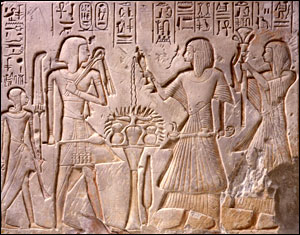
Oriental Establish, University of Chicago, OIM 10507 Seti I and his son, the future Ramesses the Great.
Limestone.
New Kingdom, Dynasty xix, Reign of Seti I, ca. 1291-1279 B.C.
Purchased in Cairo, 1919.
This relief was probably commissioned by the two priests shown at the correct to commemorate their function in the religious cult of the royal family. Showing oneself in the presence of the male monarch was a great honor.

Oriental Institute, University of Chicago, OIM 10589 Djedhor and his daughters.
Basalt.
Reign of Philip Arrhidaeus, ca. 323 B.C. Athribis.
Purchased in Egypt, 1919.
Ancient Egyptians were extremely interested in fashion and its changes. This seems axiomatic from trends seen in tomb scenes where the costumes and styles of the upper classes were presently copied by the lower classes. The most mutual fabric for clothing (both women'due south and men's) was linen. Because linen is very hard to dye, most wearing apparel were off-white, then color was added with heavy beaded collars and other jewelry. The standard apparel of women from the Old Kingdom into the New Kingdom was the sheath dress, which could exist worn strapless or with two broad shoulder straps. Virtually examples of these dresses reach the ankles. Nigh sources draw women wearing impossibly tight and impractical dresses, suggesting that the representations are arcadian to emphasize the sensuality of the female body. The most aboriginal garment worn by men was a kilt that was made of a rectangular piece of linen cloth wrapped rather loosely around the hips, leaving the knees uncovered. Equally a rule, information technology was wrapped around the body from right to left so that the edge of the brim would be in the front. The upper border was tucked backside the tie, or girdle, that held the kilt together. This garment was the standard male attire for all classes from peasants to royalty, though the quality of the linen and the exact style varied according to one's purchasing power. Some of the fancier, more expensive kilts had bias-cut edges, pleated decorative panels, or fringed edges, and were made of finer, softer linen. By tardily Dynasty 4 and early Dynasty 5, it became fashionable to wear the kilt longer and wider or to wear information technology with an inverted box pleat that appeared as an cock triangular front piece. Though styles changed over time, the simple kilt remained the standard garb for scribes, servants, and peasants. During the New Kingdom, when Egypt extended its political influence east into Asia, Egyptian fashion inverse radically. With the influx of merchandise and ideas from the east, fashions became more varied, changed more than quickly, and oft took on an eastern season. Men and women of the upper classes, for example, wore layers of fine, nearly transparent kilts and long- or short sleeved shirts that tied at the neck, or draped themselves in billowing robes of fine linen that extended from neck to ankle and were drawn in at the waist past a sash. The better examples of these garments were heavily pleated, and some were ornamented with colored ball fringe. For most of the Pharaonic Menses, women wore their hair (or wigs) long and straight; subsequently Dynasty 18 hairstyles became more elaborate. During all periods men wore their hair short, simply they too wore wigs, the manner befitting the occasion. These wigs were made of human being pilus or plant cobweb. Both genders wore copious amounts of perfumes and cosmetics fabricated of ground minerals and globe pigments. Fashion statements were made with accessories such as jewelry and ribbons. Men likewise carried staffs that marked status and social grade.
In the winter, the middle and upper classes wore a heavy cloak extending from neck to ankle, which could be wrapped around and folded or clasped in front. Depictions of such cloaks extend from Archaic to Ptolemaic times. Although sandals of blitz and reeds are known, regardless of the occasion or social class, Egyptians apparently often went barefoot. 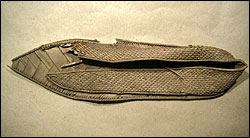
Oriental Institute, Academy of Chicago, OIM 7189 Shoe.
Rush.
Ptolemaic-Roman, 2nd century B.C.-second century A.D. Fayum, Grave H 17.
Gift of the Egypt Exploration Fund, 1901-two.
There is much testify for the leisure activities of the ancient Egyptians. Men engaged in physical sports, such as hunting, angling, archery, wrestling, boxing, and stick fencing. Long-distance races were organized to demonstrate physical prowess, and both men and women enjoyed swimming. Board games were popular, and games boards were synthetic of a number of materials: wood, stone, clay, or simple drawings scratched on the ground. Moves on board games were determined past throw sticks, astragali (creature anklebones), or later on the late New Kingdom, cubic dice that were usually marked in the same pattern used today. I of the most common games was senet, which was played on a lath of thirty squares divided into three rows of x squares. Like so many other aspects of Egyptian culture, senet had a religious significance, and the game was likened to passing through the underworld. A game board in the form of a coiled snake was amidst the earliest Egyptian games. Using a set of king of beasts-shaped and round markers, play started at the snake's tail, which was in the form of a bird'south head. The two or four opponents raced each other to the goal located in the snake's head. Mehen was the name of the serpent deity whose coils protected the sun god. The game of 20 squares was played by 2 opponents, each of whom had v playing pieces. Play began with the pieces placed on the undecorated areas on each side of the lath. The players moved down the side squares and up the center of the board. Plays were adamant with throw sticks, dice, or knucklebones. Religious texts signal that playing the game was likened to passing through the underworld in the quest for eternal rebirth. The "20 square game," which originated in Sumer and was known through the unabridged ancient Near Eastward and Cyprus, was played on a rectangular board divided into three rows of four, twelve, and four squares, respectively. Both senet and twenty squares were played by ii opponents. Another ancient game was mehen, played by several players on a round board that looked similar a coiled snake. The playing pieces, tiny lions and minor balls, were moved from the tail of the serpent to the goal on its head. Although this game was played in Egypt only during the Old Kingdom, it continued to exist played in Cyprus for some other 1,000 years. The foundation of all daily or banquet meals, regardless of social class, was the same: breadstuff, beer, and vegetables. The latter included leeks, onions, garlic, a number of pulses (beans, peas, lentils, etc.), and several varieties of melons. Wealthier Egyptians had more opportunities to enjoy red meat, fowl, honey-sweetened cakes and other delicacies. Lower-class Egyptians relied on fish and fowl for most of their meat proteins. The ready availability of wild fish and fowl made them inexpensive, while beef and, to a varying extent, other red meats were expensive and considered past many to exist a luxury. The national beverage in ancient Egypt was beer, and all aboriginal Egyptians--rich and poor, male and female--drank great quantities of it. Wages were paid in grain, which was used to make two staples of the Egyptian diet: bread and beer. Beer was made from barley dough, then bread making and beer making are oftentimes shown together. Barley dough destined for beer making was partially baked and and then crumbled into a large vat, where it was mixed with water and sometimes sweetened with appointment juice. This mixture was left to ferment, which it did quickly; the liquid was and then strained into a pot that was sealed with a clay stopper. Ancient Egyptian beer had to be drunk shortly after it was made because it went apartment very rapidly. Egyptians made a variety of beers of different strengths. Forcefulness was calculated according to how many standard measures of the liquid was fabricated from i hekat (4.54 liters) of barley; thus, beer of strength 2 was stronger than beer of strength 10. Wines in aboriginal Egypt, like wines today, were recognized by their vintage, often identified by the name of the village, town, district, or general geographic region where it was produced. At least 14 different vino-producing areas existed in the Delta alone; although the extent of these regions cannot be defined, their general location can be identified--Upper Egyptian vintages were not every bit numerous equally those of the Delta, merely were said to exist of excellent quality (e.yard., Theban wines were known for their lightness and wholesomeness). Wines were also known to have been produced in the oases. Vino jar labels normally specified the quality of wine, such equally "good wine," "sweet wine," "very very skilful vino," or the variety, such equally pomegranate wine. It is difficult to speculate most the gustation of Egyptian wine compared to modern standards. Withal, considering of the climate, low acid (sweet) grapes probably predominated, which would take resulted in a sweet rather than dry out wine. Alcohol content would take varied considerably from surface area to area and from vintage to vintage, merely generally Egyptian wine would have had a lower alcohol content than modernistic table wines. Along with eating and drinking went dance and vocal. Dancing seems to accept been a spectator sport in which professionals performed for the guests. As a rule, men danced with men and women with women. Singers, whether soloists or entire choruses accompanied by musical instruments, entertained guests in private homes and in the palace. During the New Kingdom, many new instruments were added to the instrumental ensemble, including small shoulder-held harps, trumpets, lutes, oboes, and seven-stringed lyres. Trumpets were generally restricted to the military. Egyptian lutes had a long slender neck and an elongated oval resonating chamber made of wood or tortoise shell (the sound emitted from these instruments would have been something approximating a cross between a mandolin and the American banjo). The cylindrical pulsate, most 1 meter high with a leather skin laced on at each end, was also popular during the New Kingdom; it was used both by the war machine and civilian population. The long oboe, played with a double reed, was introduced to Egypt from Asia Modest, and during the Graeco-Roman period, a number of instruments of Greek origin were adopted by the Egyptians, including pan-pipes and a water organ with a keyboard. Although the sound quality of the ancient instruments can in some cases be recreated, no prove exists that the Egyptians ever developed a organisation of musical notation; thus the ancient melodies, rhythms, and keys remain unknown. Some scholars believe, nevertheless, that vestiges of the aboriginal music may be found in the music of the peoples now living in Western Desert oases, and these songs are being scrutinized for their possible origins. In contrast to the banquets of the rich and the organized meetings of the lower classes, a different blazon of entertainment was provided by inns and beer houses where drinking often led to singing, dancing, and gaming, and men and women were free to interact with each other. Taverns stayed open up late into the night, and patrons drank beer in such quantities that intoxication was not uncommon. In one aboriginal text a teacher at a school of scribes chastens a educatee for his nighttime activities: "I accept heard that you abandoned writing and that you whirl effectually in pleasures, that you become from street to street and it reeks of beer. Beer makes him cease being a man. It causes your soul to wander . . . Now you stumble and fall upon your abdomen, existence all-powerful with dirt" (Caminos 1954: 182). The streets of larger towns no uncertainty had a number of "beer halls," and the aforementioned text every bit simply quoted refers to the "harlots" who could exist institute there. Proverbs warning young men to avoid fraternization with "a woman who has no house" indicate that some form of prostitution existed in ancient Egyptian order. For case, the "Instructions of Ankhsheshenqy" admonish, "He who makes love to a woman of the street will take his pocketbook cutting open on its side" (Lichtheim 1980: 176). During the Graeco-Roman menses, brothels were known to exist near town harbors and could be identified by an erect phallus over the door, and tax records refer to houses that were leased for the purpose of prostitution. Prostitution was not, however, associated with temples or religious cults in Egypt.
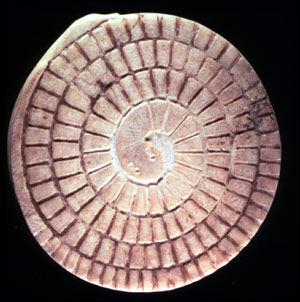
Oriental Institute, University of Chicago, OIM 16950 Snake (Mehen) game.
Egyptian alabaster, paint.
Old Kingdom, Dynasties three-6, ca. 2750-2250 B.C.
Purchased in Egypt, 1934.
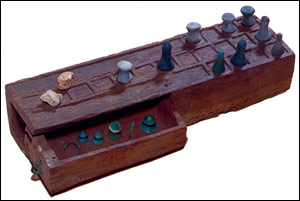
Oriental Institute, Academy of Chicago, OIM 371 20 square game.
Acacia wood, copper.
New Kingdom, Dynasties 18-19, ca. 1570-1069 B.C. Akhmim?
Purchased in Egypt, 1894-5.
Tomb paintings indicate that banquets were a pop form of relaxation, at least for the upper class. At such events nutrient, alcoholic beverages, music, and dancing were common forms of entertainment. The system of the tomb scenes may be misleading, it seems that proprieties of the times kept male and female guests seated in split up areas although men and women performed together. 
Oriental Institute, University of Chicago, OIM 9819, 9820 Game markers.
Faience, ivory.
New Kingdom and later, ca. 1300-300 B.C.
Purchased, 1920.
In addition to beer, wine was also widely drunk. Jar labels with notations that the wine was from the "Vineyard of Rex Djet" indicate that wine production was well established as early as Dynasty 1. By Dynasty 5 and half dozen, grapevines and wine production were mutual motifs in busy tombs, and records imply that some vineyards produced considerable amounts of wine. One vineyard, for example, is said to accept delivered one,200 jars of good vino and fifty jars of medium-quality wine in one yr. 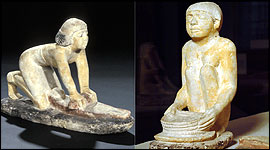
Oriental Institute, University of Chicago Nykauinpu figures: woman grinding grain (left) and winnower (right).
It has been suggested that the furnishings of drinking wine were sometimes enhanced past additives. For example, tomb paintings often describe vino jars wrapped or draped in lotus flowers, suggesting that the Egyptians may accept been aware of the narcotic qualities of blue lotus petals when mixed with wine. There is much evidence for the backlog consumption of both beer and wine, and King Menkaure (Dynasty 4) and King Amasis (Dynasty 26) figure in tales about drunkenness. Some ancient scenes are quite graphic in their depiction of over-indulgence. For instance, in the tomb of Paheri an elegant lady is shown presenting her empty cup to a servant and saying "give me 18 measures of vino, behold I should love [to drink] to drunkenness." 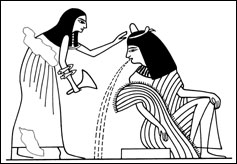
Douglas J. Brewer and Emily Teeter A woman who over-indulged (Dynasty 19).
Ancient Egyptians played a variety of musical instruments. Of the air current instruments, one of the oldest was a flute made of reed or forest, and illustrated on Predynastic pieces of broken pottery (i.e., sherds) also as on a slate palette from Hierakonpolis. By the Old Kingdom, single and double flutes were played. They could be side-blown (much like a modern flute), or end-blown (similar a recorder). The flute always remained popular amongst Egyptians and it has survived to this twenty-four hour period equally the Arabic nay and uffafa. Also pop during the Erstwhile Kingdom were large floor harps and various percussion instruments ranging from bone or ivory clappers to hand-rattles (sistra) and rectangular or round frame drums. Drums of all sizes were played using fingers and hands; sticks or batons were apparently not used. 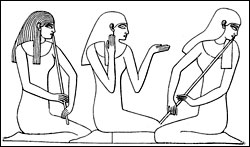
Oriental Institute, University of Chicago Musicians entertain at a banquet (Dynasty 18).
Almost THE AUTHOR
Douglas J. Brewer
Douglas J. Brewer is professor of anthropology at the University of Illinois, Urbana, and manager of the Spurlock Museum. He has written four books and numerous articles on Egypt, and has spent xviii years involved in field projects in Egypt, including research on the natural history of the Eastern Desert, the Palaeolithic / Neolithic transition in the Fayum, and excavations concerned with the Predynastic and Dynastic culture of the Nile Valley.
About THE Writer
Emily Teeter
Emily Teeter is research associate and curator of ancient Egyptian and Nubian antiquities at the Oriental Constitute Museum, University of Chicago. She is the author of a wide diversity of books and scholarly articles well-nigh Egyptian religion and history, and has participated in expeditions in Giza, Luxor, and Alexandria.
COPYRIGHT This seminar is extracted from Affiliate seven of
morenodozedilitry.blogspot.com
Source: https://fathom.lib.uchicago.edu/2/21701778/
0 Response to "Which of the Following Is Not Correct About Marriage and Family in Ancient Egypt?"
Post a Comment